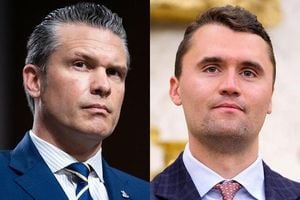On a balmy Monday in late July 2025, Bill McCubbin, a spry 102-year-old and former Ford dealer from Madison, Indiana, found himself rolling through the hallowed halls of Ford Motor Company’s world headquarters. But this wasn’t just any visit. McCubbin, who first opened his dealership back in April 1961, was granted a rare, up-close look at Ford’s Heritage Fleet—a collection of some of the most storied and elusive vehicles the automaker has ever produced. For a man whose life has revolved around the blue oval, it was a trip down memory lane, packed with nostalgia and a few surprises that even a seasoned car man like him hadn’t anticipated.
According to reporting by the Detroit Free Press, the Ford Heritage Fleet is not open to the public, but rather serves as a source of inspiration for employees and select groups with deep connections to Ford. The collection includes everything from the 10 millionth Ford Mustang, built at the Flat Rock Assembly plant, to the 1999 Ford Thunderbird Concept and a series of Ford’s famed GT supercars. These vehicles aren’t just museum pieces—they’re symbols of the company’s evolution, innovation, and enduring legacy.
McCubbin’s journey to Dearborn was set in motion by his daughter, Nancy Starr, who, after catching a CBS News segment on the Heritage Fleet, reached out to Ford’s Heritage brand manager, Ted Ryan. What followed was a whirlwind of arrangements, culminating in a private tour that also included a look at the ongoing rehabilitation of Michigan Central Station, another ambitious Ford project aiming to breathe new life into Detroit’s iconic train station.
Clad in a white ballcap adorned with the blue Ford oval, McCubbin reminisced with Free Press reporters about his early days as a dealer. One story stood out: an encounter with Lee Iacocca, the legendary Ford executive, who once showed McCubbin a Mustang concept during a trip to Detroit. That connection, McCubbin recalled, proved invaluable. “That was the greatest investment I ever made because I got every Mustang I ever asked for,” he said, reflecting on how coveted the Mustang was in its early years. “Mustangs were hard to get in 1964 and ’65.”
McCubbin’s path to dealership ownership wasn’t exactly planned. He’d originally accompanied someone else interested in buying the Madison dealership, but when that deal fell through, McCubbin was offered the chance to buy it himself—with financing, no less. It turned out to be a fortuitous twist of fate, launching a career that would span decades and leave a lasting mark on southeastern Indiana’s automotive scene. His son, Kevin McCubbin, eventually took over the dealership, selling it in 2021, according to madisoncourier.com.
Over the years, McCubbin developed a particular fondness for certain models. He fondly recalled his 1964 Lincoln convertible and a 1957 Thunderbird, which he sold for a tidy profit. “The Lincoln was a nice specimen despite a few issues, and I loved Thunderbirds,” he shared. But of all the vehicles he encountered during his tour of the Heritage Fleet, it was the concept cars that left the deepest impression.
Despite his appreciation for modern automotive advancements, McCubbin isn’t entirely sold on today’s technology. He’s especially critical of the proliferation of touch-screen controls, even in his own 2023 Lincoln Corsair. “I like everything about the cars today, but they have transferred too much to the screen,” he said, echoing a sentiment shared by many car enthusiasts who long for the tactile feedback of traditional buttons and dials.
McCubbin’s story is remarkable not just for his automotive achievements, but for his resilience and vitality. A Navy veteran, he piloted an infantry landing barge during five Pacific invasions in World War II and worked at the Willow Run bomber plant before joining the service. Even at 102, he remains active, typically walking a mile a day on a treadmill—though he boasted he’d managed a mile and a half just the weekend before his interview. He credits his longevity to a lifetime of moderation, regular gym work, and, curiously, a general avoidance of butter—except when it comes to apple pie. “Never was a butter guy, except on my mother’s and my wife’s apple pie. Always put a lot of butter on that sometimes,” he admitted with a grin.
While McCubbin was reliving the golden era of American motoring, another Ford Mustang was busy making headlines of its own in Washington, D.C. On August 7, 2025, the White House made an immediate, somewhat unconventional request: it needed two brand-new 2025 Ford Mustang GT muscle cars, and it needed them fast. The reason? To support a high-stakes recruitment drive for the U.S. Immigration and Customs Enforcement agency (ICE).
According to federal procurement documents obtained by Detroit Free Press, the government shelled out $121,450 for the pair, bypassing the typical competitive bidding process due to what it described as a "compelling" and "urgent" need. The Mustangs were sourced from Banister Ford of Marlow Heights, Maryland, which just happened to have the right cars in stock. Dan Banister, the dealership owner, told the Free Press he had no idea the White House was the buyer. “I didn’t know it was the White House. Donald Trump didn’t call me,” Banister joked, adding that it was likely just “luck” that his dealership landed the sale.
The urgency behind the purchase was tied to a massive ICE hiring initiative. Congress had recently approved $30 billion to bring on approximately 14,000 new immigration officers over the next two fiscal years. But with morale reportedly low and recruitment proving a challenge, ICE hoped the Mustang GTs—described in procurement documents as “bold, high-performance symbols of innovation, strength and modern federal service”—would help attract top talent at recruitment events. “Its eye-catching design increases public engagement at outreach events and helps attract top talent by conveying a culture of excellence and forward momentum,” the documents explained.
One of the Mustangs was spotted in D.C. on August 18, decked out with a gold ICE logo and the words “Defend the homeland” emblazoned on the side. This wasn’t ICE’s first foray into flashy recruitment vehicles, either. The agency had previously spent more than $700,000 customizing a fleet of SUVs and pickups—including a Ford Raptor and a GMC Yukon—painted to mimic the look of Donald Trump’s private Boeing 757, complete with navy blue paint, red-and-white racing stripes, and gold lettering.
The procurement documents made it clear: “Without timely access to these resources, our ability to attract and onboard qualified candidates will be severely hindered, ultimately impacting the agency’s ability to fulfill its mission.” Banister, for his part, was just happy to help. “We sell to a wide range of customers including individuals, businesses and government agencies. We don’t take any political position on who purchases a vehicle,” he said, adding, “The Mustang is a great vehicle.”
For Ford, the Mustang’s enduring appeal is clear—whether it’s inspiring a centenarian dealer or helping the federal government recruit its next generation of agents. The car’s legacy, much like McCubbin’s, is built on a blend of tradition, innovation, and a dash of American bravado. And as both stories show, sometimes the road ahead is best traveled with a little horsepower and a lot of heart.



